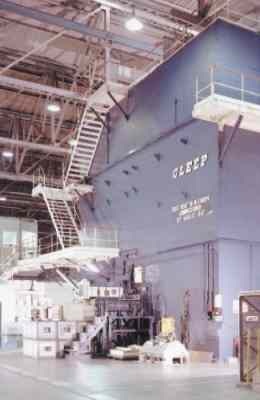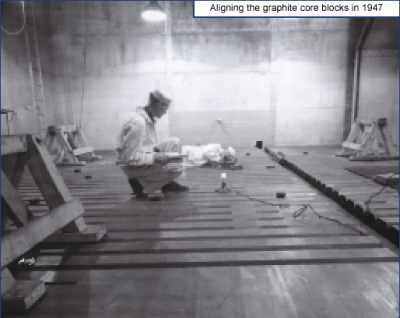| UKAEA ANNOUNCES CONTRACT TO
DECOMMISSION WESTERN EUROPE'S FIRST NUCLEAR REACTOR
The contract for its dismantling has been let to Renfrew based Mitsui Babcock. Decommissioning is planned to be completed by autumn 2004. GLEEP played a key role in the development of civil nuclear energy in Britain. It was used in investigations into how to make a nuclear reactor work including the early design and development of Magnox nuclear fuel used in commercial generating stations operating today. It was later used as an international standard for testing materials for other nuclear reactors and for calibration. After 43 years of operation, GLEEP was shut down in 1990 and in 1994/95, the fuel rods and control rods were removed. The final phase of GLEEP's decommissioning and the complete removal and dismantling of the reactor will allow the removal of two hangars and other associated buildings, freeing the eastern end of the Harwell site in Oxfordshire for new development. Total cost of the decommissioning and other demolition work is around £10 million. Dr John McKeown, Chief Executive of UKAEA commented: "The decommissioning of GLEEP is a landmark in the environmental restoration of Harwell and the transformation of the site into an international business centre. The removal of GLEEP, together with other redundant buildings at the front of the Harwell site, will pave the way for delicensing and development of the eastern area of the site." Managing Director of Mitsui Babcock, Europe, Iain Miller added: "We are extremely pleased to be awarded this contract. We have worked closely with UKAEA and sub-contractors to develop a 'best practice' solution for decommissioning GLEEP and restoring this part of the Harwell site for development." Re-development of the site began with the launch of Harwell International Business Centre in 2000. The Gemini office block was built in partnership with ProLogis Developments Ltd in 2001. By releasing more land for unrestricted use, it is hoped to create a thriving hub of science and technology on the Harwell-Chilton campus. The new Diamond Synchrotron being built on the campus which will create 500 science and technology jobs.
UKAEA is working to restore the environment of its Harwell site, removing the nuclear legacies and releasing the land for unrestricted use as a science and technology park. UKAEA has devised a comprehensive plan to develop Harwell so that it can provide quality accommodation and facilities for companies working in the fields of science and technology - from start-up companies to fully developed international organisations. The site has an overall development ceiling of 2.5 million sq ft of new and existing space. Harwell International Business Centre combines an international reputation for scientific excellence with a business environment for the 21st century. The Centre is one of the UK's premier locations for commercial industry working in the fields of science and technology. Organisations based at Harwell service customers in science, government and commercial sectors worldwide. They include The Medical Research Council, Harwell Dosimeters, Harwell Scientifics, Oxford Drying Restoration Services, Amersham, Regenesys Technologies and REVISS Services (UK). Background Objectives Key challenges Solution The control rods from the core and other external equipment were removed in 1995. Fuel being retrieved during Stage One decommissioning. Outcome Stage Three decommissioning is planned for 2003-2005. |
 The
United Kingdom Atomic Energy Authority (UKAEA) today announced the
final decommissioning of the first reactor in Western Europe. GLEEP -
the Graphite Low Energy Experimental Pile - first went critical in 1947
and was shut down in 1990.
The
United Kingdom Atomic Energy Authority (UKAEA) today announced the
final decommissioning of the first reactor in Western Europe. GLEEP -
the Graphite Low Energy Experimental Pile - first went critical in 1947
and was shut down in 1990. GLEEP
was the first reactor in Europe and was operational from 1947 - 1990.
Generally operating at 3kW, GLEEP was used for initial investigations into
how a reactor would work and later as an international standard for
materials testing and calibration. GLEEP was closed in 1990.
GLEEP
was the first reactor in Europe and was operational from 1947 - 1990.
Generally operating at 3kW, GLEEP was used for initial investigations into
how a reactor would work and later as an international standard for
materials testing and calibration. GLEEP was closed in 1990.